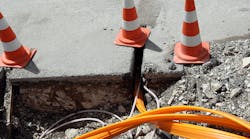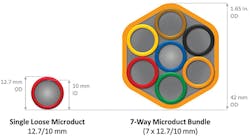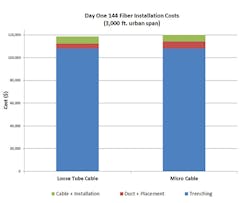5 Reasons Why Micro Cables Can Help Transform Networks
Micro cables were developed out of necessity in Europe in the early 2000s. There, the majority of optical fiber cable was installed underground and, as bandwidth demands and fiber requirements in the region grew rapidly, free space in which to install new cables quickly decreased. Legacy conduits became critically congested with large traditional loose tube cables, driving the need for smaller cables with higher fiber counts that could be installed with less cost and disruption than a rip-and-replace solution.
With its greater land mass, more recently established cities, and greater reliance on aerial installations, conduit space in North America has historically been congestion-free. But now, similar challenges as those faced across the Atlantic are on the horizon. Between 2007 and 2015, AT&T saw traffic in its core network grow 100,000% due to increased smartphone use and video consumption (Fortune, 2015). Verizon likely faced similar growth, but halted its rollout of FiOS due to cost (timesunion, 2015). These facts show that keeping up with consistently increasing bandwidth demands can be prohibitively expensive.
That said, without investment in new cable pathways, legacy duct congestion can quickly become an issue. Fortunately, though, by swapping traditional loose tube cables and standard ducts for miniaturized micro cables and microducts, operators can more easily meet short-term fiber demands and also provide unique, cost-effective deployment techniques for flexible, scalable upgrades in the future.
What Are Micro Cables and Why Use Them?
Micro cables are miniaturized stranded loose tube cables which are up to 50% smaller and up to 70% lighter than traditional loose tube cables. Miniaturization is achieved through a reduction in buffer tube diameter and a thinner outer jacket. The buffer tubes each still contain the typical 12 colored optical fibers and maintain their SZ stranding; even though they are functionally equivalent, micro cables are less rugged than traditional loose tube cables. For this reason, a micro cable is typically installed in a microduct: a miniaturized plastic conduit which can be used to subdivide internal duct space into smaller compartments.
Microducts are available in single or "bundled" varieties (as shown in Figure 1), and each design provides different benefits depending on the deployment scenario. Loose microducts can be installed into an empty, or even occupied, legacy subduct to optimize the use of existing space; multipath bundles allow for flexible and scalable high-fiber-count, high-density cabling in new installations.
Figure 1. Example of typical microduct designs.
There are 5 key reasons why micro cables make sense.
Reason #1
Optimized use of legacy infrastructure
Micro cables allow for more fibers in smaller spaces, meaning more fibers can be accommodated in the valuable, ever-decreasing space inside legacy-installed ducts. With a 96-fiber loose tube cable placed within a duct with a typical inner diameter of 1.25 in (~1.65 in outer diameter), there would be enough space to install a second 96-fiber cable. However, overpulling loose tube cables is not recommended as both the new and existing cables can be damaged. Alternatively, the operator could perform a 12.7/10 mm microduct override and install a 144-fiber micro cable. As the microduct is so light, it could safely be installed alongside the loose tube cable and allow the operator to increase the duct’s overall fiber count by 150%, delaying the need for retrenching at relatively little expense and risk.
Reason #2
Future-ready greenfield deployments
Operators can only perform as many microduct overrides as the space in their ducts allows. Sooner or later, brand-new infrastructure will be required and when it is, a multipath microduct bundle is a wise choice. With an outer diameter of around 1.65-in, a seven-way bundle with 12.7/10 mm microducts can accommodate a total of 1,008 fibers in the same space as the most common traditional conduit.1 Furthermore, the bundle is functionally equivalent to the traditional duct in terms of tensile strength and bend radius, meaning minimal disruption from an installation perspective.
Reason #3
Ultimate fiber capacity with high-density micro cables
The benefits of miniaturization have also been realized with optical fiber. Since it was first invented, optical fiber has evolved from multimode to low-attenuation single-mode fiber, and now 200 micron fiber represents the latest in this innovation process. Such fibers maintain a 125 micron glass cladding (for G.652 and G.657 fiber interoperability) but feature a reduced coating diameter of 200 micron (versus the traditional ~242 micron) that enables highly efficient fiber packing during the cabling process.
This innovation in optical fiber has facilitated the development of high-density micro cables that are up to 20% smaller than standard micro cables. In addition, 200 micron fibers have a 23% smaller cross-sectional area than ~242 micron fibers, meaning operators can choose to have the same fiber count in a smaller diameter cable, or a higher fiber count with no increase in diameter.
A common 1.25-in duct can accommodate a loose tube cable that provides a maximum of 432 fibers; and as already discussed, a seven-way microduct bundle could house seven 8.1 mm, 144-fiber micro cables and provide up to 1,008 fibers — 133% more than the loose tube solution. However, by using 24 fibers per buffer tube, a high-density micro cable provides 216 fibers in the same space as the standard micro cable (8.0 mm), for a maximum capacity of 1,512 fibers in the bundle — 250% more than the loose tube solution.
Reason #4
Pay as you grow
Sources estimate that civil works can account for up to 80% of total broadband deployment costs and, due to the high cost of excavation (particularly in urban areas), deploying either a 1.25-in duct or microduct bundle would be equally costly at first.2 As shown in Figure 2, there would be little difference in the Day One cost of deploying either a 144-fiber loose tube cable or a 144-fiber standard micro cable in a seven-way microduct bundle in a 3,000 ft urban span.
Figure 2. Day One cost comparison: 144 F loose tube and micro cables.
However, the true value of microtechnology would be revealed upon performing a capacity upgrade beyond the initial 144 fibers. As shown in Figure 3, adding loose tube capacity would require further excavation that would cost almost $120,000 and take up to 30 days to complete. In comparison, a micro cable increase would cost $6,000 to purchase and install a new 144-fiber micro cable into 1 of 6 vacant microducts. This process could be completed in a single day, and repeated up to 5 times before retrenching becomes a consideration.
Figure 3. Capacity upgrade cost comparison: 144 F loose tube and micro cables.
Reason #5
Practical advantages for efficient, cost-effective installations
Not only do micro cables enable simple, economical capacity upgrades, they also enable easier, more cost-effective cable installations. Though they can be pulled at low tension over short distances, micro cables are generally blown or jetted into microducts using air-assisted blowing machines. However, due to the reduction in cable size, installers can use smaller, less-expensive blowing machines, air compressors, and handholes, compared with traditional loose tube installation apparatus.
In addition, 50% smaller cables also mean twice as much cable on a transportation reel, or simply smaller reels, for lower transportation and storage costs.
Finally, the installation process can be managed by as few as 3 installers: one to operate the blowing machine, another to pay-off the cable from the transportation reel, and a third to monitor the cable as it exits the microduct at the end of the span.
Conclusion
Originally rising to prominence in the congested legacy networks of Europe, fiber-dense micro cables will now allow network operators in North America to meet looming future capacity demands by building cost-effective modern networks based upon flexible, scalable microduct architecture. The deployment of new optical infrastructure can be a daunting prospect due to the high cost of civil works, but using microtechnology on Day One means that costly, disruptive re-excavation can be postponed far into the future. Moreover, smaller, lighter cables translate to an easier deployment with a lower total cost, lighter equipment, fewer network components, and smaller installation crews.
Endnotes and References
1. Seven 144-fiber micro cables = 1,008 fibers in total.
2. Fiber to the Home Council, Europe (2014)
Vanian, Jonathan. "AT&T CEO: "Half of our mobile network traffic is video," Fortune. 12 June 2015, http://fortune.com/2015/06/12/att-randall-stephenson-video-traffic/ (18 November 2016)
Rulison, Larry. "Verizon says FiOS roll out stopped because of cost as it defends against redlining claims," timesunion. 26 October 2015, http://www.timesunion.com/business/article/Verizon-says-FiOS-roll-out-stopped-because-of-6591620.php (18 November 2016)
About the Company: Corning offers a full micro cable portfolio in North America, including MiniXtend® cables with binderless* FastAccess® technology, which reduce cable access time by as much as 70%; and MiniXtend HD cables which harness the power of 200 micron optical fiber and are even smaller, even lighter, and offer fiber counts up to 288 fibers. For more information on MiniXtend cables or micro cable applications, please contact your local Corning sales representative or visit www.corning.com/minixtend/ise.
*Corning’s patented binderless FastAccess® technology refers to the combination of a Corning FastAccess technology jacket with an innovative technology used to bind cable construction through the manufacturing process, eliminating the use of binder yarns and waterblocking tapes.
Save
Save
Save
Save








